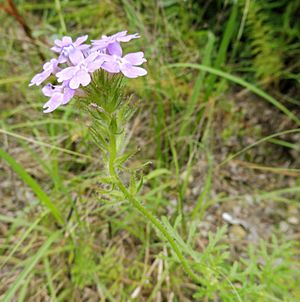Dakota mock vervain facts for kids
Quick facts for kids Dakota mock vervain |
|
|---|---|
 |
|
| Scientific classification | |
| Genus: |
Glandularia
|
| Species: |
bipinnatifida
|
| Synonyms | |
|
|
Glandularia bipinnatifida, often called Dakota mock vervain or prairie verbena, is a pretty flowering plant. It belongs to the verbena family, known as Verbenaceae.
About the Dakota Mock Vervain
This plant is also sometimes called "Moradilla." It is a type of plant that can grow back year after year. This means it is a perennial plant. It can be either soft and leafy (herbaceous) or slightly woody.
Where It Grows
The Dakota mock vervain is native to North America. You can find it growing from the United States all the way south to Nicaragua. In the U.S., it grows mostly in the Great Plains area. It also appears in the Blackland Prairies in the Southeast.
This plant likes open, grassy places. It grows well in natural areas like prairies. You might also see it in places where the ground has been disturbed.
What It Looks Like
The Dakota mock vervain usually has pink or purple flowers. It blooms mostly in the spring. However, you might see its flowers at any time during the warmer months.
Its leaves are special. They are deeply cut into many small, narrow parts. These parts are usually about 1 to 4 millimeters wide.
It looks a bit like another plant called Glandularia pulchella. But you can tell them apart by looking closely. The Dakota mock vervain has longer parts under its flowers, called bracts. Its leaf parts are also wider than those of Glandularia pulchella.
See also
 In Spanish: Glandularia bipinnatifida para niños
In Spanish: Glandularia bipinnatifida para niños

